- News
- Reviews
- Bikes
- Accessories
- Accessories - misc
- Computer mounts
- Bags
- Bar ends
- Bike bags & cases
- Bottle cages
- Bottles
- Cameras
- Car racks
- Child seats
- Computers
- Glasses
- GPS units
- Helmets
- Lights - front
- Lights - rear
- Lights - sets
- Locks
- Mirrors
- Mudguards
- Racks
- Pumps & CO2 inflators
- Puncture kits
- Reflectives
- Smart watches
- Stands and racks
- Trailers
- Clothing
- Components
- Bar tape & grips
- Bottom brackets
- Brake & gear cables
- Brake & STI levers
- Brake pads & spares
- Brakes
- Cassettes & freewheels
- Chains
- Chainsets & chainrings
- Derailleurs - front
- Derailleurs - rear
- Forks
- Gear levers & shifters
- Groupsets
- Handlebars & extensions
- Headsets
- Hubs
- Inner tubes
- Pedals
- Quick releases & skewers
- Saddles
- Seatposts
- Stems
- Wheels
- Tyres
- Health, fitness and nutrition
- Tools and workshop
- Miscellaneous
- Tubeless valves
- Buyers Guides
- Features
- Forum
- Recommends
- Podcast
review
£650.00
VERDICT:
Very good value, ideal for anyone looking for a first road bike, with just the brakes as a low point
Weight:
9,480g
Contact:
At road.cc every product is thoroughly tested for as long as it takes to get a proper insight into how well it works. Our reviewers are experienced cyclists that we trust to be objective. While we strive to ensure that opinions expressed are backed up by facts, reviews are by their nature an informed opinion, not a definitive verdict. We don't intentionally try to break anything (except locks) but we do try to look for weak points in any design. The overall score is not just an average of the other scores: it reflects both a product's function and value – with value determined by how a product compares with items of similar spec, quality, and price.
What the road.cc scores meanGood scores are more common than bad, because fortunately good products are more common than bad.
- Exceptional
- Excellent
- Very Good
- Good
- Quite good
- Average
- Not so good
- Poor
- Bad
- Appalling
The Trek 1.2 is a very good value option that would be an ideal choice if you're after your first road bike.
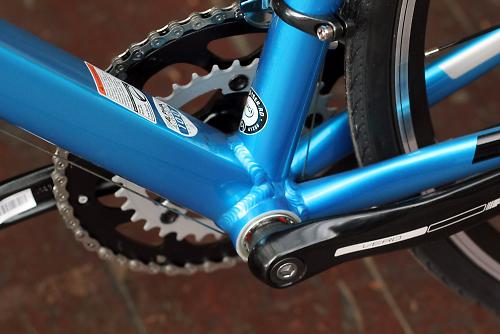
The 1.2 is the middle of Trek's three 1 Series aluminium road bikes, sitting between the Shimano Claris-equipped 1.1 (£575) and the 1.5 (£750), which comes with Shimano Tiagra components.
Is it the right bike for you? We've picked out four reasons why it might be, along with a reason that might make you think twice.
1 It provides solid performance with few surprises
The 1.2 puts in a solid performance out on the road, offering a stable, predictable ride, the only real disappointment being the lack of braking power (see below).

Hitting the scales at 9.48kg (20.9lb), the 1.2 isn't as lively as many lighter bikes, but for £650 this is certainly a decent enough weight. Compared to bikes of a similar price, it accelerates well. You'll find a little more flex in the frame and fork than in higher level models in Trek's range, but this is a bike that's well capable of holding its own when you crank up the power.
You could't say that the 1.2 is the fastest climber but it's far from sluggish when things get lumpy. It's helped in its hill-climbing endeavours by a compact chainset (with 50-tooth and 34-tooth chainrings rather than 52 or 53 and 39). Most bikes of this price come with something similar these days. Matched up to an 11-28-tooth cassette, it'll allow you to get up the vast majority of gradients without your knees popping or your lungs bursting, while still providing enough big gears to keep you bowling along quickly on the flat and downhill.
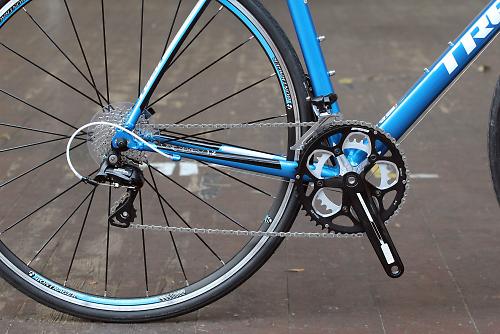
Aluminium frames have a reputation for feeling harsh but that's a gross generalisation. Some are jarring – as some carbon frames are – but plenty aren't. This bike is certainly comfortable enough for racking up the big miles.
For a start, it comes in Trek's H2 fit. That requires a brief explanation. Compared to Trek's H1 fit, H2 has a taller head tube: 3cm taller in the case of our 58cm test model. Why? It puts you into a more upright riding position with less strain on your lower back and neck. You could achieve a similar position by adding a bunch of headset spacers on an H1 bike, but if you want your bars at that height, you're better off going for an H2 fit because the front end will be stiffer and the handling will be better.
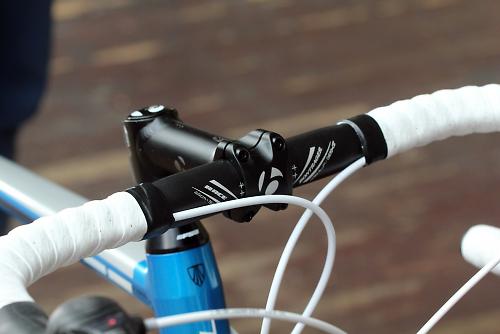
The Bontrager Race VR-C alloy handlebar has a shallower drop than usual too: 124mm rather than the 145mm you get on Bontrager's Race Lite Classic, for example. That means it's that much easier to get down on the drops. A lot of people have a bar with a deep drop and rarely take their hands off the hoods.
The other reason for the comfort is that the 1.2 is inherently pretty smooth. Sure, there are plenty of bikes out there that will filter our more road vibration but this one does a decent enough job on that front. Swapping the 23mm tyres for 25s would add more comfort but this bike isn't crying out for them by any means.
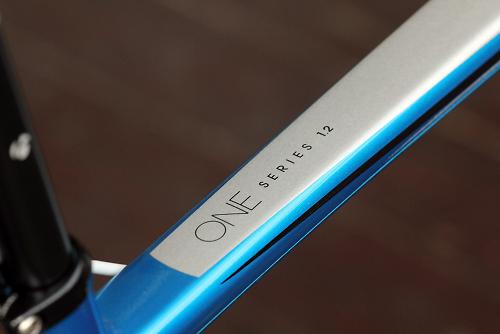
The Bontrager Gel Cork bar tape provides good cushioning for your hands and the Bontrager Affinity 1 saddle has plenty of padding too. Truth be told, I found it a little too soft, verging on squidgy, but everyone has their own taste when it comes to saddles.
2 You get a neat, well-proven frame and fork
All three bikes in the 1 Series share the same 100 Series Alpha Aluminium frame. It's fairly busy looking with a squared off upper edge to the down tube that makes it resemble that of Trek's more costly Madone.
The top tube slopes towards the seat tube junction and tapers down as it does so, and slim seatstays provide compliance at the back.
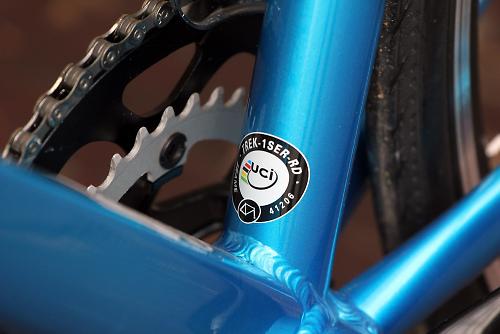
You get mounts for a mudguard and a rack back there too. They'll be useful if you want to ride the bike year round and perhaps carry stuff to and from work on a daily commute.
You don't get the oversized bottom bracket or tapered head tube that are regular features designed to add stiffness to higher-end performance bikes, but this is a £650 bike and the frame is good for the money. The welds are pretty tidy throughout and the same can be said of the paint job.
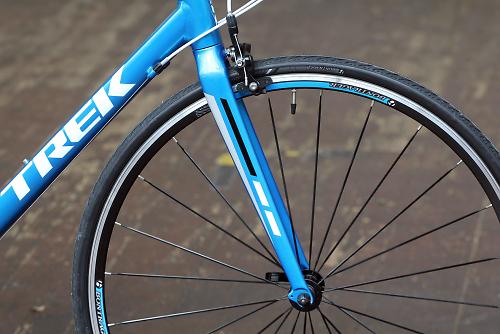
The fork is Trek's own with carbon blades and an alloy steerer. Like the frame, it comes with eyelets for fitting mudguards that will save a lot of faffing.
It's worth noting that the Trek 1.2 is available in eight sizes from 47cm up to 62cm. That range will cover nearly everyone.
3 Shimano's Sora shifters and mechs are excellent for the money
Nine-speed Sora is Shimano's fifth tier road groupset (if you don't count the electronic variants) and it offers fantastic value for money.
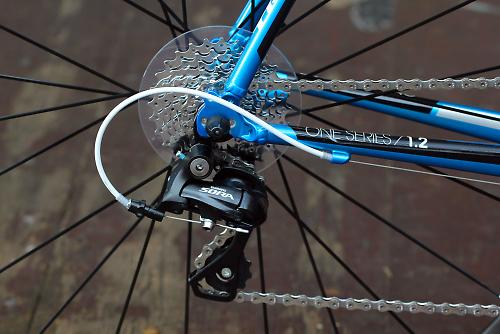
Back in the olden days (before last year), you changed gear on Sora by pushing the brake lever to the side or by using a small thumb lever on the side of the shifter body, depending on the direction you wanted to shift.
Now, though, Sora levers are Dual Control, so instead of that thumb lever, there's a lever tucked behind the brake lever. It's the same design that Shimano use right up to top-level Dura-Ace and it's a big improvement, making it far easier to change gear from the drops.
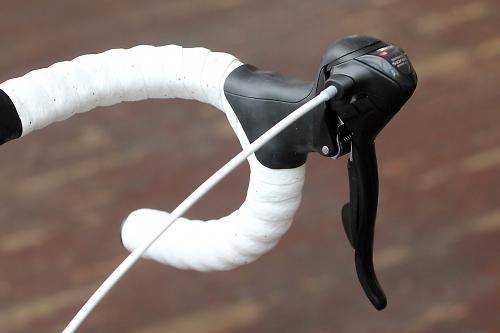
Resting your hands on the hoods is comfortable and there's a little gear indicator on the top of each of the levers that you might find useful. I can't say I ever checked them – I just couldn't get into the habit – but they're there if you want to.
Whereas the gear cables run underneath the bar tape on Shimano's higher level groupsets, they head out from the side of the levers with Sora and loop around to the frame in the fresh air. That's certainly not a problem from a functional point of view, although visually it's a less tidy way of doing things. That's being picky, though. Sora shifting has taken a massive leap forward with this latest design. It works very much like the highest level offerings from Shimano, just adding a little weight. Even there, the difference isn't massive.
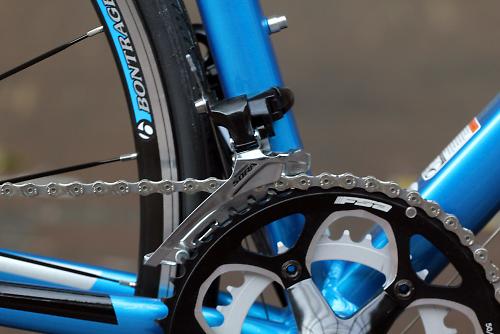
Trek don't give you a complete Sora groupset here, just the shifters and mechs. The chainset is FSA Vero, a square taper design that does its job just fine, and the brakes, as mentioned, are unbranded.
Most other big brand bikes at this price, such as the Giant Defy 3 (£649) and the Felt F95 (£649), have Shimano Sora components too. It's worth comparing the spec sheets to see exactly how they match up, but don't buy a bike solely on that basis.
4 Bontrager's wheels and other components are good, reliable kit
The wheels are made up from Bontrager's own alloy hubs, containing cup and cone (rather than cartridge) bearings, and Tubeless Ready http://www.bontrager.com/technology/why_tubeless_ready rims. That means you can run the wheels without inner tubes at some point in the future, although you'll need to upgrade to Tubeless Ready tyres first.
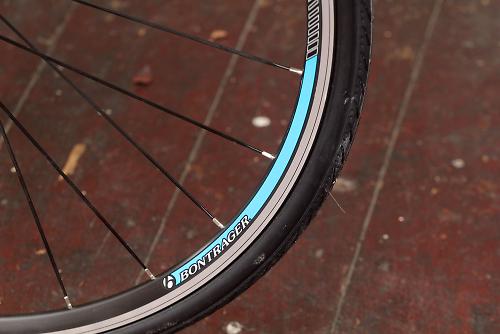
The tyres that come fitted as standard are Bontrager's T1s (700 x 23). They're some pretty hefty rubber, made for durability rather than all-out speed, but they're reasonably resistant to punctures and they hold the road well even in damp conditions.
I had no problems at all with the wheels during the month-long test period. They're not the lightest wheels ever, taking some coaxing up to speed, but they're still as round and as true as they were out of the box, and there's a lot to be said for trouble-free operation. Fast wheels aren't so fast when you're standing on the side of the road trying to remove a broken spoke.
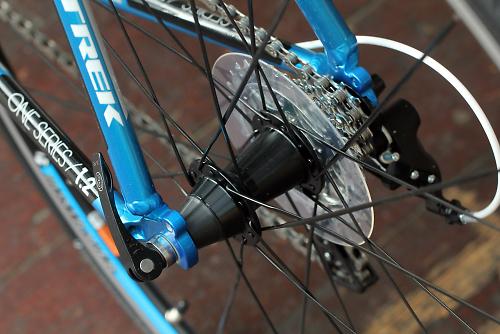
Most of the rest of the kit is no-nonsense stuff from Bontrager too, the handlebar, stem and seatpost being reliable alloy options and the Affinity 1 saddle providing at least as much cushioning as most people will want.
And the compromises
There are no two ways about it, the 1.2's brakes are disappointing. Trek have put the Shimano Sora theme to one side here and specced nameless dual pivot callipers that lack bite. Don't get me wrong, they're consistent and they'll stop you, just not as quickly as you might like. You have to engage the brakes for a bit longer than normal or pull the levers a bit harder to get down to your desired speed.

You adjust to this within a ride or two and don't really think about it until you ride with people who have better brakes on their bikes, or jump back on to a bike with better brakes yourself. Then you're struck by the contrast.
Swapping the brake pads helps, but the bottom line is that these brakes are a compromise to make a price point and, for me, they're the weakest aspect of the entire bike.
Other compromises? There's nothing that really stands out. Trek offer a decent all-round package here.
Summing up
The Trek 1.2 is a very good bike for the money. The frame and fork are sound, reliable options and the Sora shifters and mechs are better than anything previously available for this kind of cash. They're a great example of the benefits of trickle down technology.
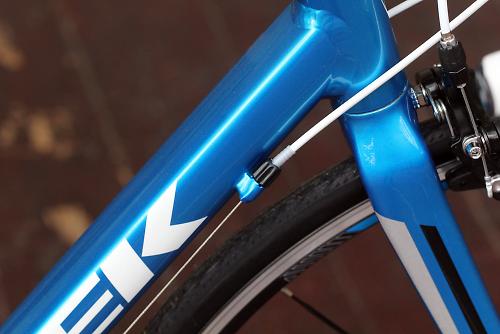
Yes, if you pay a couple of hundred pounds more you'll get a lighter bike that leaps into life more eagerly when you up the intensity for a sprint or tough climb, but that's always the way. As it is, the Trek 1.2 is a very able road bike that'll reward your efforts with decent speed, and it's comfortable enough to ride all day long. The fact that it comes with mudguard and rack eyelets increases its versatility, so you can use it as a year-round workhorse if that's what you're after.
We'd have no hesitation recommending this bike for someone after their first proper road bike, or for anyone else looking for plenty of value.
Verdict
Very good value, ideal for anyone looking for a first real road bike, with just the brakes as a low point
road.cc test report
Make and model: Trek 1.2
Size tested: 58
About the bike
State the frame and fork material and method of construction. List the components used to build up the bike.
Frameset
Frame 100 Series Alpha Aluminium
Fork Trek carbon road
Sizes 47, 50, 52, 54, 56, 58, 60, 62cm
Wheels
Front hub Bontrager alloy
Rear hub Bontrager alloy
Rims Bontrager Tubeless Ready
Tyres Bontrager T1, 700x23c
Drivetrain
Shifters Shimano Sora, 9 speed
Front derailleur Shimano Sora
Rear derailleur Shimano Sora
Crank FSA Vero, 50/39/30 (triple)
Cassette SRAM PG-950, 11-28, 9 speed
Pedals Nylon body w/alloy cage, toe-clip/strap
Chain KMC X9
Components
Saddle
Bontrager Affinity 1
Seatpost Bontrager Alloy, 2-bolt head, 27.2mm, 8mm offset
Handlebar Bontrager Race, VR-C, 31.8mm
Stem Bontrager Elite Blendr, w/computer & light mounts, 31.8mm, 7 degree
Headset 1-1/8" semi-cartridge bearings
Brakeset Alloy dual-pivot
Accessories
Bar tape Bontrager gel cork tape
Tell us what the bike is for, and who it's aimed at. What do the manufacturers say about it? How does that compare to your own feelings about the bike?
Trek say: "1 Series aluminium road bikes feature the same aero shaping and race-ready detail as our top-end bikes. They're strong, light, and built to fly over the pavement," [Trek, being from the US, use "pavement" to mean the surface of a road rather than a path].
Frame and fork
Overall rating for frame and fork
8/10
Tell us about the build quality and finish of the frame and fork?
It's a tried and tested frame built to a high quality. The same goes for the carbon leg/alloy steerer fork.
Tell us about the materials used in the frame and fork?
The frame is made from aluminium: what Trek call 100 Series Alpha Aluminium.
Tell us about the geometry of the frame and fork?
The 1.2 is built to Trek's H2 geometry that I've explained in the body of the review. Essentially, it's slightly more relaxed than a full-on aggressive race position, but it's still speed orientated.
How was the bike in terms of height and reach? How did it compare to other bikes of the same stated size?
It's a little taller at the front end than a traditional low and stretched road bike.
Riding the bike
Was the bike comfortable to ride? Tell us how you felt about the ride quality.
I found it comfortable both in terms of ride position and ride quality. It's certainly a long way from being a bone shaker.
Did the bike feel stiff in the right places? Did any part of the bike feel too stiff or too flexible?
It's not mega-stiff but it's not too flexy either.
Which components had the most effect (good or bad) on the bike's comfort? would you recommend any changes?
I found the saddle a touch too squidgy for my taste, but I'd rather that than too firm.
Rate the bike for efficiency of power transfer:
7/10
In all of these marks, I'm comparing the bike to similarly priced alternatives.
Rate the bike for acceleration:
7/10
Rate the bike for sprinting:
7/10
Rate the bike for high speed stability:
8/10
Rate the bike for cruising speed stability:
8/10
Rate the bike for low speed stability:
8/10
Rate the bike for climbing:
7/10
The drivetrain
Rate the drivetrain for performance:
8/10
Rate the drivetrain for durability:
8/10
Rate the drivetrain for weight:
8/10
Rate the drivetrain for value:
8/10
Wheels and tyres
Rate the wheels and tyres for performance:
8/10
Rate the wheels and tyres for durability:
8/10
Rate the wheels and tyres for weight:
7/10
Rate the wheels and tyres for comfort:
8/10
Rate the wheels and tyres for value:
7/10
Controls
Rate the controls for performance:
9/10
Rate the controls for durability:
8/10
Rate the controls for weight:
8/10
Rate the controls for comfort:
9/10
Your summary
Did you enjoy riding the bike? Yes.
Would you consider buying the bike? It would certainly be on my shortlist if I was after a bike at about this price.
Would you recommend the bike to a friend? I'd recommend it should be on their shortlist too.
Rate the bike overall for performance:
8/10
Rate the bike overall for value:
8/10
Anything further to say about the bike in conclusion?
Nearly all big brand bikes at this price have these features: aluminium frame, fork with carbon legs and alloy steerer, an incomplete Shimano Sora groupset (chainset and brakes being the most frequent omissions), in-house aluminium handlebar, stem and seatpost. If you simply compare spec lists, you'll see that the 1.2 comes out better than some and not quite as well as others.
However, we'd caution against making a decision based solely on a comparison of spec sheets. We've not reviewed all of the 1.2's chief rivals, but we can tell you that this bike will provide you with a very good all-round performance, the brakes being the only real low point.
About the tester
Age: 43 Height: 190cm Weight: 75kg
I usually ride: My best bike is:
I've been riding for: Over 20 years I ride: Most days I would class myself as: Expert
I regularly do the following types of riding: commuting, club rides, sportives, general fitness riding,
Mat has been in cycling media since 1996, on titles including BikeRadar, Total Bike, Total Mountain Bike, What Mountain Bike and Mountain Biking UK, and he has been editor of 220 Triathlon and Cycling Plus. Mat has been road.cc technical editor for over a decade, testing bikes, fettling the latest kit, and trying out the most up-to-the-minute clothing. He has won his category in Ironman UK 70.3 and finished on the podium in both marathons he has run. Mat is a Cambridge graduate who did a post-grad in magazine journalism, and he is a winner of the Cycling Media Award for Specialist Online Writer. Now over 50, he's riding road and gravel bikes most days for fun and fitness rather than training for competitions.
Latest Comments
- lonpfrb 3 hours 30 min ago
PCCs are an attempt to provide Legitimacy by connecting an elected representative to the oversight of Policing. Thus voter surveys to sample...
- ktache 4 hours 18 min ago
Mine tend to get knocked by the chaining of the bicycle, then fall off later. To be found next time I use the light. Some crushed.
- ktache 4 hours 21 min ago
I'm guessing not that very manoeuvrable either.
- Simon E 5 hours 34 min ago
That is a pity, Malcolm had a great reputation and spent a lot of time posting his no-nonsense advice gained over many years on Bikeradar....
- Rendel Harris 5 hours 47 min ago
It's a mark of how weak your pompous pontificating is that you're forced to make up things I never said in order to try to defend your "look at me...
- SaveTheWail 7 hours 29 min ago
'I was so lucky that I was doing the speed limit' (!) http://www.bbc.com/news/articles/c17d598vj0qo
- Blackthorne 8 hours 50 min ago
It's mentioned in benefit #2 in the article...
- levestane 9 hours 2 min ago
Pneu ballon and hookless rims are back, I still have some 27" Birmalux rims in the shed somewhere.
- brooksby 10 hours 51 min ago
Well yes, but it is the holidays
- Rendel Harris 12 hours 3 min ago
Thank you for that excellent forensic analysis, I couldn't figure out where I'd gone wrong! Must drink more coffee and put on glasses before trying...



























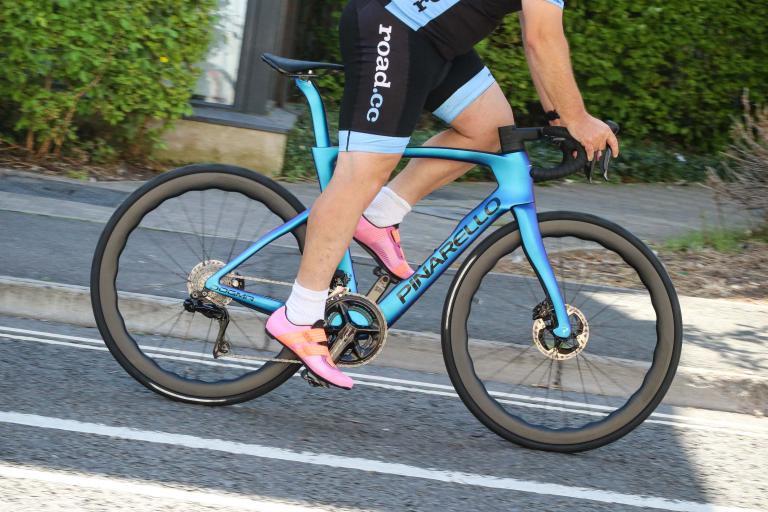
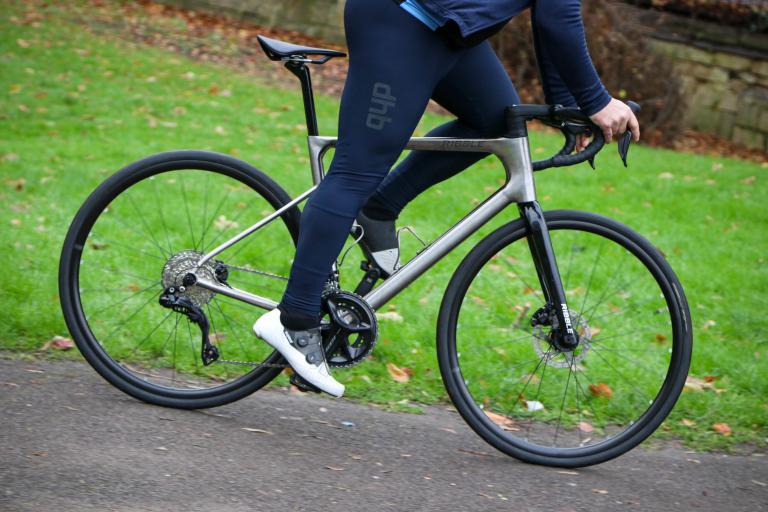


Add new comment
13 comments
I'm riding this bike now for over 6 years. Inexpensive when bought for €600. Needed maintenance about 2 years ago which was about €400 (new wheelset, cassette/chain/cabling etc).
I've replaced the 700x23-tyres by 700x25-tyres a long time ago without changing anything else. Works like a charm.
Great value for the money but brakes could indeed be better. Meanwhile looking to add a new bike (and use this one solely on the Tacx) with disc-brakes.
The current Trek 1 Series bikes have plenty of clearance for fixed mudguards, even with a 25mm tyre. The 2013 1.2 had little clearance, and this was because Trek used the 2 series frame for that particular year. I'm guessing evo_playa has one of these.
Agree that SKS Raceblade Long guards are great. The lack of availability is due to a redesign - SKS are developing the new version to allow for bikes with disc brakes. I gather they won't be available until this autumn at the earliest. UK distributors sold out of the old versions months ago.
Seems like a comparable spec and set up to other value bikes. Agree that even low spec bikes are good and has recently made me question my prior choice of 105 or nothing. Anyone know if Claris is any good ? Always found the Trek styling a bit bland but this one looks ok. The latest B twin road bikes seem anazing value if your in the market for a new bike.
www.tinpony.co.uk/shop
The 8 speed Sora front and rear Derailleurs on my Trek are long since worn out and were replaced with Claris just before the winter kicked in. It works really smooth with no problems - even on the old Sora shifters with thumb button.
I've had the 2011 1.1 with shimano 2300 (remember that?) for just over 4 years now, and it certainly scrubs up well. Even with just 2300 and a different wheelset I've raced on it for a couple of years to some success, it certainly doesn't feel like it holds me back, which is very impressive for such a cheap machine.
In fact, I like it enough to complete the change to 5700 groupset in the spring.
I can't say I ever had a problem with the brake calipers, and I can't tell the difference between the alloy calipers and the Shimano long drop calipers having swapped them out- they are certainly good enough.
However, I'm not a fan of the H2 fit with the massive head tube- I hate long head tubes and was lucky to get mine before they were introduced.
Excellent winter trainer and commuter. My 2007 Trek 1.2 is still going strong - it's had a few minor changes but still has the Sora 8 speed with thumb button - oh and a pannier rack!
It's still a lovely bike to ride and recommended first road bike.
Not a racing bike. Sit up and beg.
WHY wouldn't they put sensible 25mm tyres on the bike?
Quite. I can't really understand why they'd have clearances so tight, seems unecessary. It may be that 25mm tyres would work with some mudguards already mentioned, but probably not full guards that also help keep crud off the chainset especially in winter.
Word of warning though, if it is like my Trek 1.2 with the carbon fork you will be lucky to get a fixed mudguard that fits even though the bike has mudguard eyelets.
Clearance on the front is not good and i had to end up using Crud mudguards for the front wheel.
As ever, SKS Raceblade Longs. Sorted.
Tried quite a few including SKS chromeplastic ones.
Will look out for the Raceblade longs as they look great. Looks like most places don't stock them though.
edit: tracked them down, looks like instock here : http://www.tredz.co.uk/.SKS-Race-Blade-Long-Mudguard-Set_51833.htm
Fairly simple and inexpensive to swap out the substandard brake calipers.
I upgraded my Trek 1.1 to Shimano non series long drop brake calipers and the difference in braking was amazing.